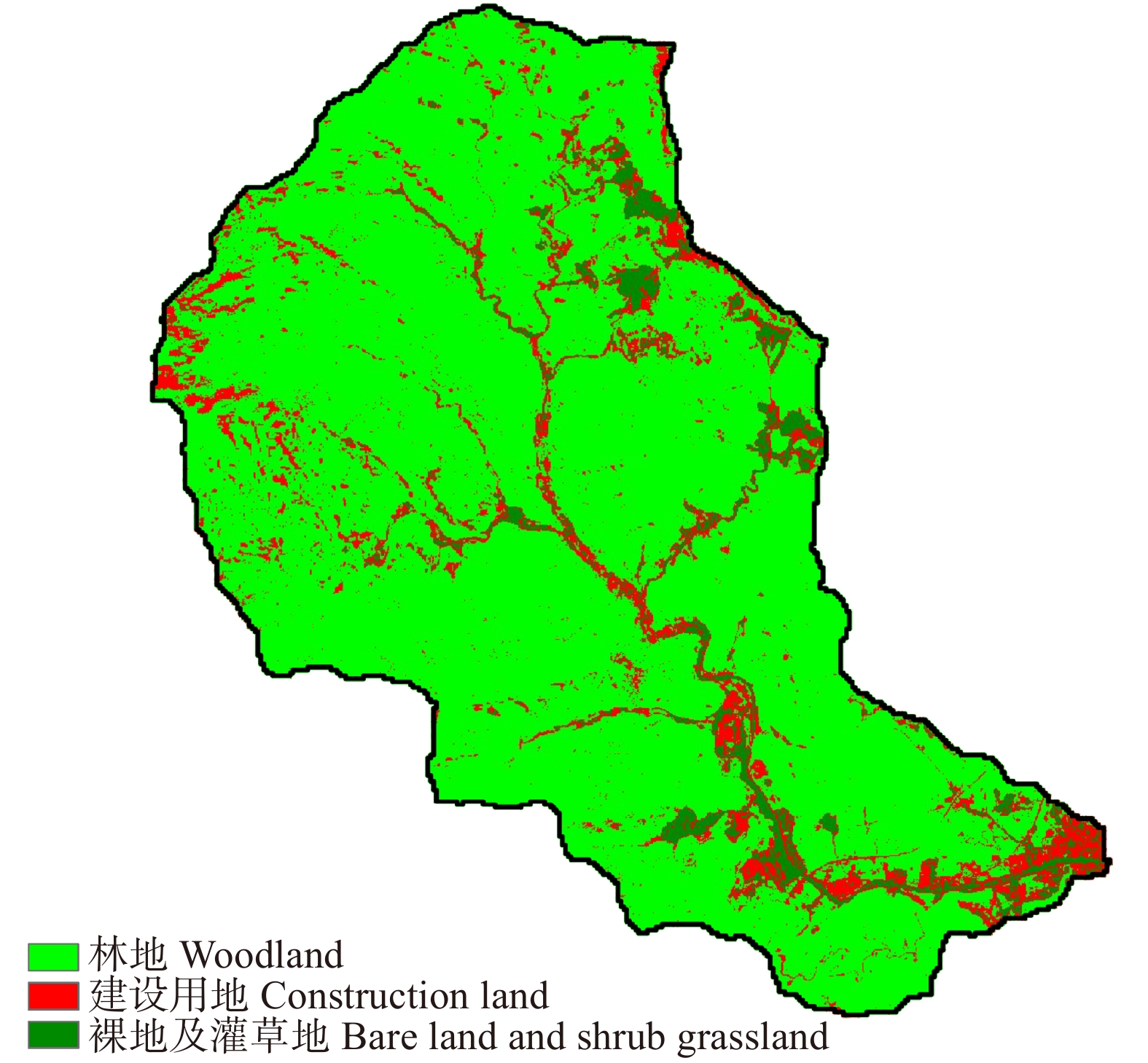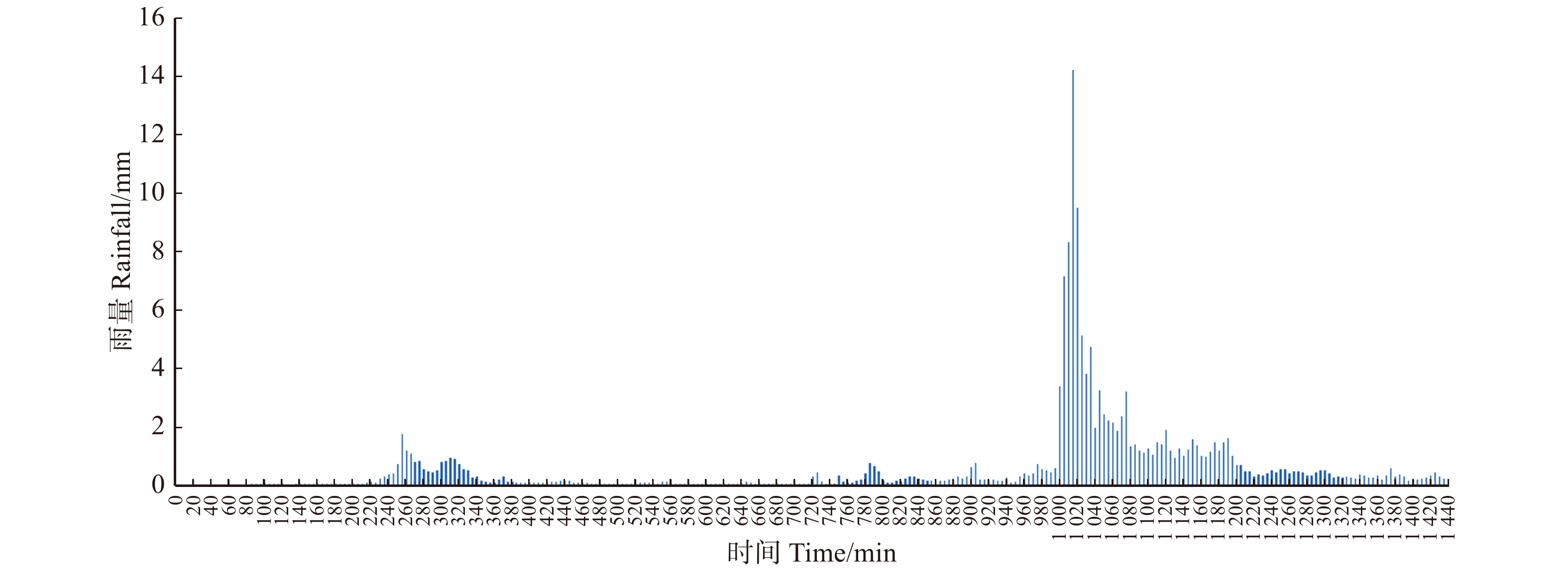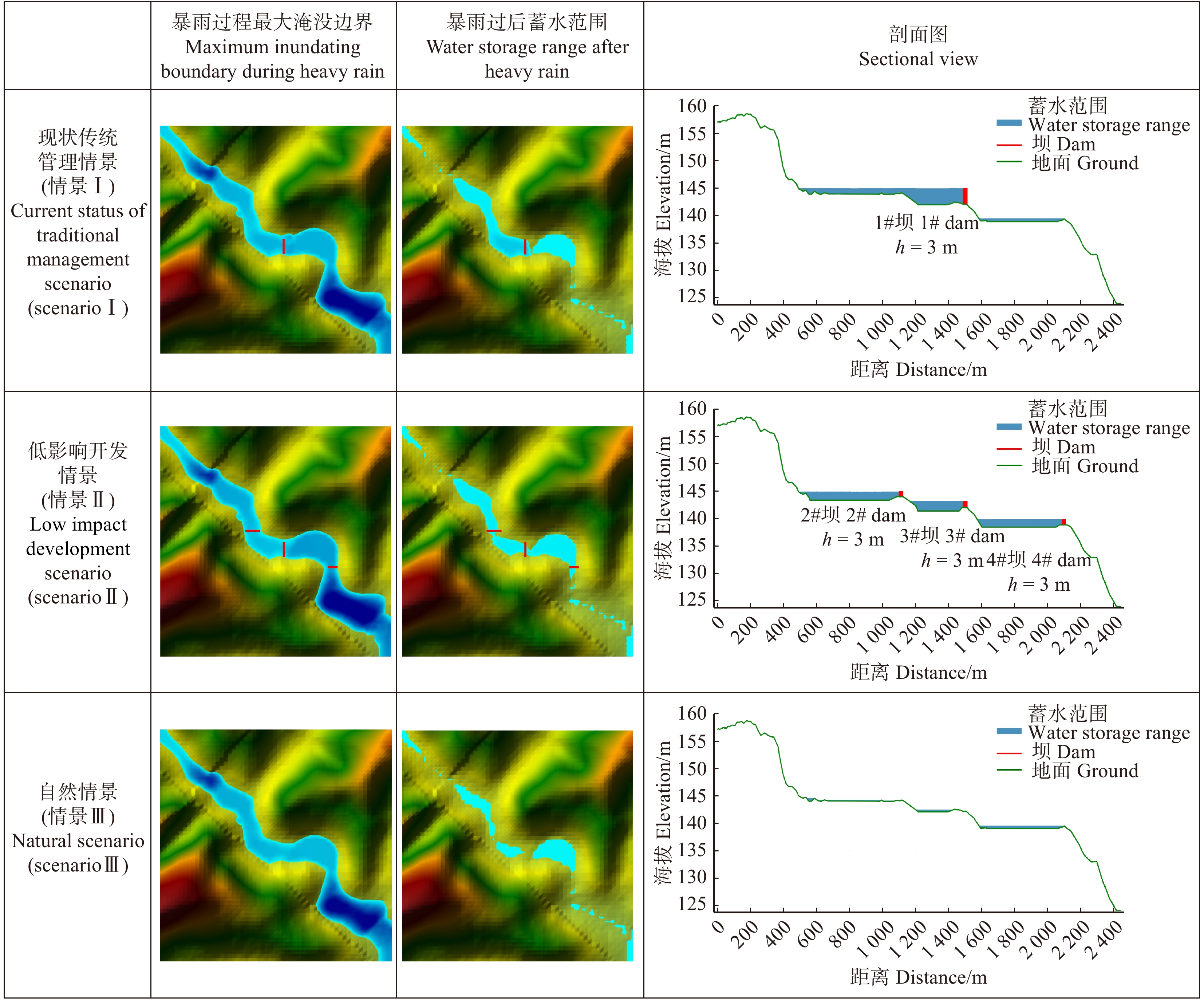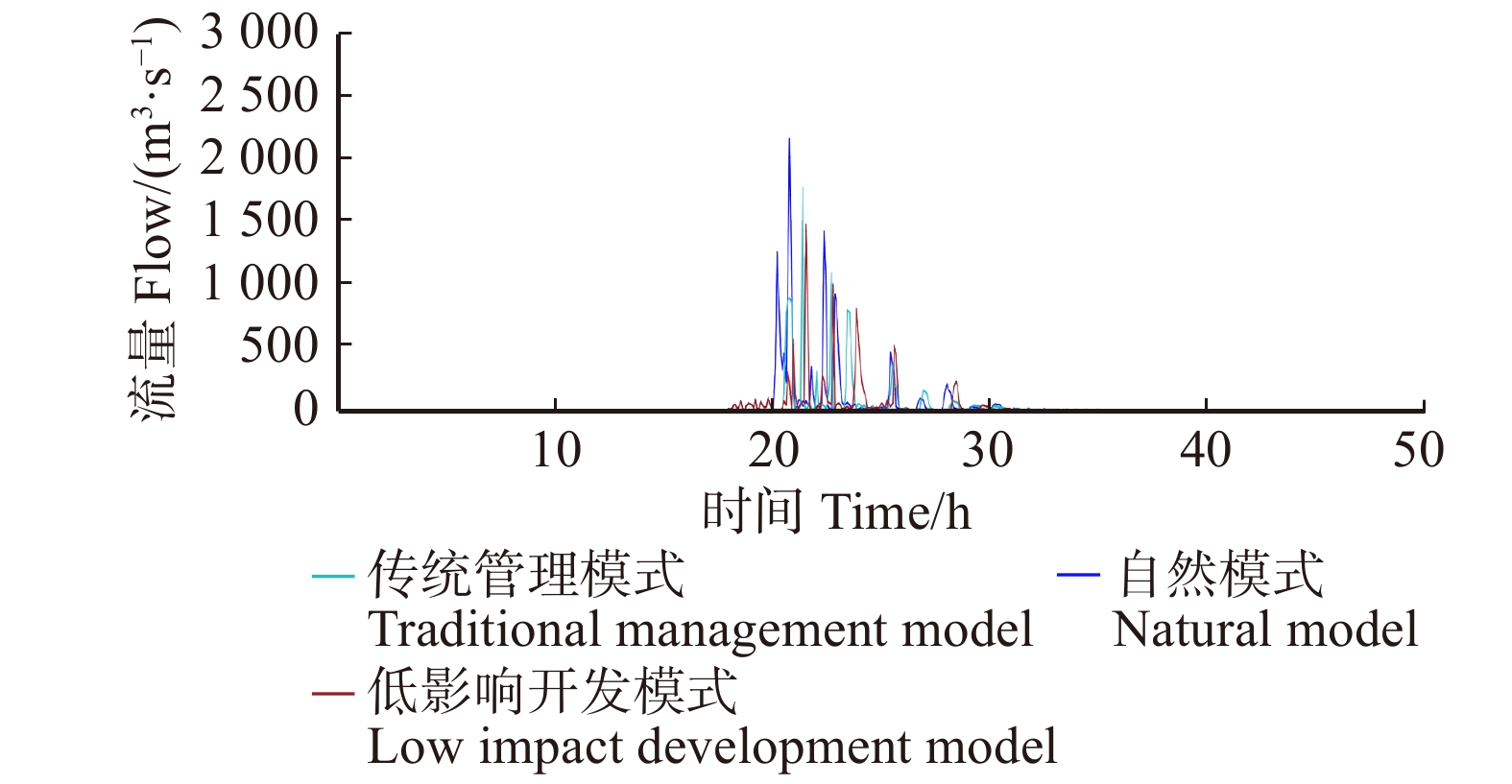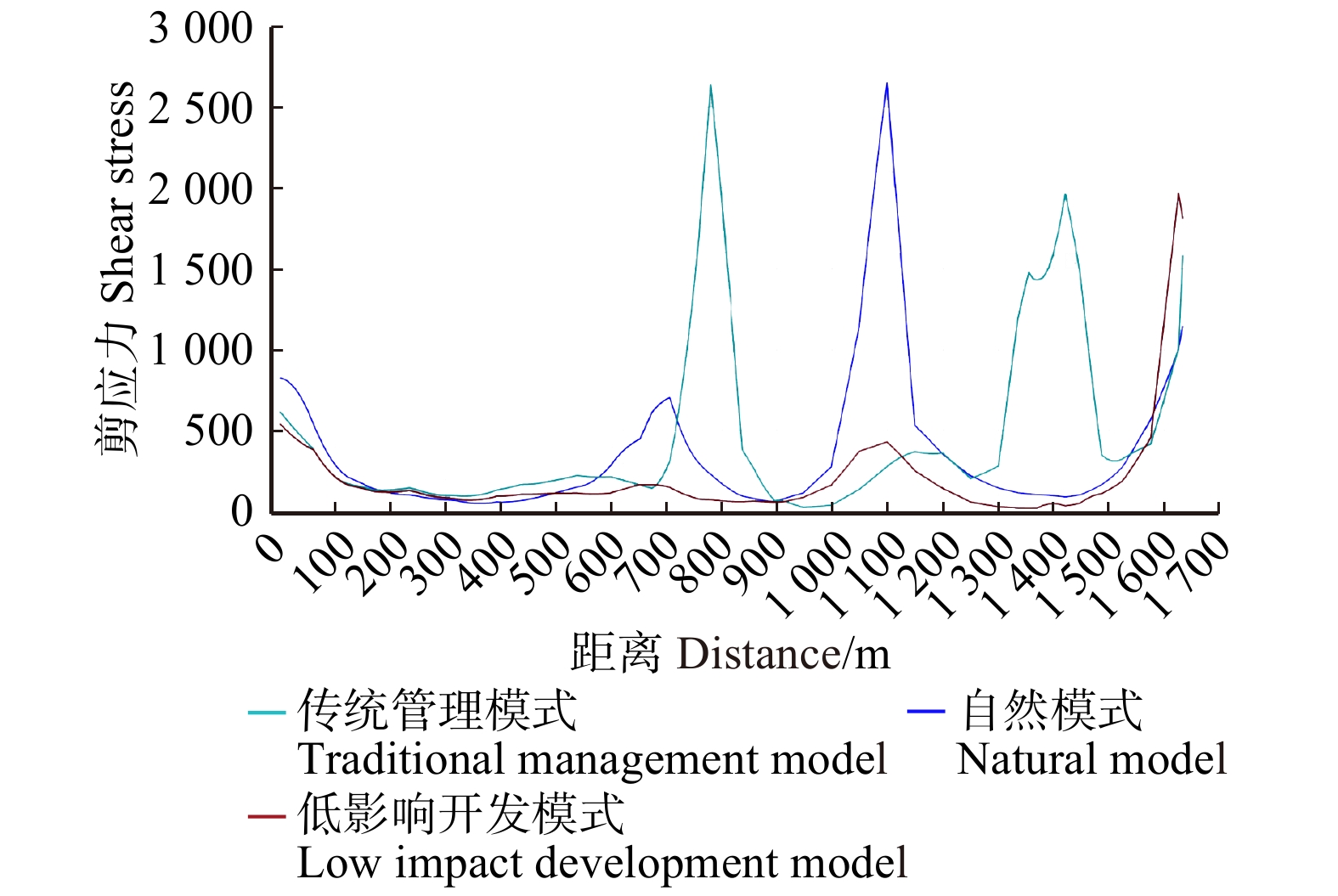Stormwater management measures in Beijing suburban hilly area based on hydrological model: taking the upper reaches of Jiakuohe River as an example
-
摘要:目的浅山区是城市的生态屏障,由于浅山区的地形坡降较大,且洪峰汇流时间较短,极易形成季节性洪水,导致雨洪灾害。本文旨在探究合理的浅山区雨洪管理方式,研究不同雨洪管理情景在山地中的适用性。方法研究以北京市浅山区夹括河上游区域为例,基于HEC-HMS和HEC-RAS等水文模型模拟10年一遇设计降雨下的雨洪径流过程,对比分析3种不同的雨洪管理情景(传统管理情景、低影响开发情景和自然情景)在雨洪调控效果、生态环境影响和景观效果3个方面的综合调控效果,从而探究不同浅山区雨洪管理措施的有效性。结果(1)在雨洪调控效果方面,传统管理情景、低影响开发情景的蓄水容量分别是自然情景下的3.8倍、5.0倍,最大淹没范围较自然情景增大了2.0%、1.2%,传统管理情景、低影响开发情景对峰值流量的削减率分别为18.3%、31.5%,峰现时间分别推迟35 min、45 min。(2)在生态环境影响方面,低影响开发模式对于河道植被环境和水文连通性的积极效应大于传统管理模式和自然模式。(3)在景观效果方面,低影响开发情景在水体范围和环境契合度方面都具有较大优势。结论(1)相比于传统雨洪管理模式,低影响开发模式具有良好的雨洪调蓄作用,能增大雨水存蓄容量、削减峰值流量、推迟峰现时间,此外低影响开发模式能改善河道生态环境,并且具有良好的景观效果。因此通过综合判断,低影响开发情景更适用于本文的研究流域中。(2)低影响开发模式能发挥浅山区的地形优势,通过在地形平缓处设计雨水蓄水池来收集上游汇水。同时低影响开发模式按照海绵城市的设计规范制定雨洪目标,实现河道上游汇水区域年径流总量控制率大于85%,兼顾了河道生态和景观的需求。(3)研究发现HEC-RAS水文模型可以量化并可视化不同雨洪管理情景,为浅山区雨洪管理建设提供技术支持。(4)研究强调每个区域的特殊性,浅山区雨洪管理措施从另一层面扩展了低影响开发情景的应用,表明传统水利设施也同样适用于低影响开发的雨洪管理理念。
-
关键词:
- 浅山区 /
- 雨洪管理措施 /
- 低影响开发 /
- HEC-RAS水文模型
Abstract:ObjectiveThe suburban hilly area is the ecological barrier of city. Due to the steep slope of terrain in the suburban hilly area and the short peak time of flood peak, it is easy to form seasonal floods, resulting in flood disasters. The purpose of this paper is to explore reasonable stormwater management methods in suburban hilly area and to study the applicability of different stormwater management scenarios in mountainous area.MethodTaking the upper reaches of the Jiakuohe River in the shallow mountainous area of Beijing as an example, the hydrological model of HEC-HMS and HEC-RAS was used to simulate the stormwater runoff process under the once in 10 years stormwater. The three different stormwater management scenarios(traditional management scenario, low impact development scenario, and natural scenario) were compared and analyzed in stormwater control effects, ecological environmental impacts, and landscape effects, thereby exploring the effectiveness of stormwater management measures in different suburban hilly areas.Result(1) In terms of stormwater control effects, the storage capacity under traditional management scenario and low impact development scenario were 3.8 times and 5.0 times of natural scenario, and the maximum flooding range was 2.0% and 1.2% higher than natural scenario. The reduction rate of peak traffic flow in traditional management scenario and low impact development scenario was 18.3% and 31.5%, respectively, and the peak current time was delayed by 35 and45 min, respectively. (2) In terms of ecological environment impact, the positive effects of low impact development model on river vegetation environment and hydrological connectivity were greater than traditional management model and natural model. (3) In terms of landscape effects, low impact development scenario had great advantages in terms of water body scope and environmental fit.Conclusion(1) Compared with the traditional stormwater management model, the low impact development model has a good stormwater storage and storage function, which can increase the stormwater storage capacity, reduce the peak flow rate, delay the peak time, and further reduce the development mode. It can improve the river ecological environment and has a good landscape effect. Therefore, through comprehensive judgement, low impact development scenario is more suitable for the research basin of this paper. (2) The low impact development model can take advantage of the topography of suburban hilly area and collect upstream water collection by designing a stormwater reservoir in a gentle terrain. At the same time, the low impact development model formulates the stormwater flood target according to the design specifications of the sponge city, and realizes that the annual total runoff control rate of the upper reaches of the river channel is greater than 85%, taking into account the river ecological and landscape needs.(3)The HEC-RAS hydrological model can quantify and visualize different stormwater management scenarios and provide technical support for stormwater management in suburban hilly area. (4) The study emphasizes the particularity of each region. The stormwater management measures in suburban hilly area extend the application of low impact development scenario from another level, indicating that traditional water conservancy facilities are also applicable to the stormwater management concept of low impact development. -
植物是依赖于光合作用生存的光能自养型生物,而光合作用的主要场所为叶绿体。叶绿体拥有自身的遗传物质DNA[1],其基因组较小,仅占植株总基因组的10% ~ 20%,呈双链闭环形式,一般为四分体结构[2],包括小单拷贝区(SSC,small single copy region),大单拷贝区(LSC,large single copy region),和两个大小相等、方向相反的反向重复区(IR,inverted repeat region)。大单拷贝区和小单拷贝区被两个反向重复区在中间隔开。叶绿体是半自主细胞器,具有独立的遗传系统,作为光合作用的中心,同时进行着多种生化反应[3]。
密码子在核酸和蛋白质之间起传递的作用[4],其偏好性会受到自然选择、基因突变、碱基组成、遗传进化、基因漂移等多种因素影响[5]。密码子偏好性可影响物种的分子进化、环境适应和基因组特征,进而影响外源基因的表达、反映物种间的进化关系,还可为引种驯化提供重要依据。通过分析密码子中碱基的使用情况,可以推断影响其使用偏好的原因。叶绿体基因组密码子对植物光合作用的机制和代谢调控具有重要意义。此前,已有研究对忍冬属(Lonicera)[6]、车轴草属(Trifolium)[7]、赖草属(Leymus)[8]、梁山慈竹(Dendrocalamus farinosus)[9]、人参(Panax ginseng)和三七(Panax notoginseng)[10]等植物的叶绿体基因组密码子偏好性进行了探讨。目前,关于油茶叶绿体基因组密码子偏好性分析的报道仅限于普通油茶(Camellia oleifera)[11]和香花油茶(Camellia osmantha)[12],研究发现其密码子偏好性不仅受到突变作用的影响,更多地受到自然选择的作用。
油茶属于山茶科(Theaceae)山茶属(Camellia),灌木或中乔木,嫩枝有粗毛,叶革质,花顶生,蒴果球形或卵圆形,与油橄榄(Olea europaea)、油棕(Elaeis guineensis)、椰子(Cocos nucifera)并称世界四大木本油料植物[13],与乌桕(Triadica sebifera)、油桐(Vernicia fordii)、核桃(Juglans regia)并称中国四大木本油料植物[14]。油茶不仅可提炼食用油,还可入药,茶枯还可作为农药、肥料,有提高农田蓄水能力和防治稻田害虫的功能[15]。小果油茶(Camellia meiocarpa)又称小子茶和江西子,因其种子形状与鸡心相似,故又称鸡心子[16]。其生长习性与普通油茶相似,适宜种植在亚热带季风气候的中低海拔山地、丘陵地区。越南油茶(Camellia vietnamensis)分布于中国广东南部、海南、广西靠近越南边界各县,以及越南和老挝。越南油茶是一种在中国广泛栽培的油料树种,栽培面积仅次于普通油茶和小果油茶。小果油茶和越南油茶是油茶资源中的两个重要栽培类型,其栽培面积在全国范围内位居前三,两者在植物学特性、地理分布、果实特征、栽培利用和亲缘关系等方面既存在显著差异,又具有一定的内在联系。借助基因测序、分子标记等现代生物技术手段,能够深入剖析小果油茶和越南油茶之间的遗传差异,为其遗传改良提供坚实的理论基础。通过对小果油茶与越南油茶叶绿体基因组密码子偏好性的研究,可以揭示二者在进化规律和突变方式上的特点,进而阐释这两个品种适应外界环境的分子机制。在此研究基础上,通过对目标基因密码子进行优化,能够显著提高基因的表达效率。这不仅为后续良种培育提供了理论依据,更为将小果油茶的适应性强、抗炭疽病能力强、产量稳定等优良性状与越南油茶生长速度快、种仁含油率高这一优势相结合,培育出更具市场竞争力的新品种奠定了基础。
截至目前,尚未有针对小果油茶和越南油茶这两个油茶近源物种叶绿体基因组密码子使用偏好性的对比研究报道。本研究以市场上常见的小果油茶和越南油茶为研究对象,拟通过相关软件对其叶绿体基因组密码子进行碱基组成分析、中性绘图、ENC-plot绘图、PR2-plot偏倚、最优密码子分析,构建高低表达库,揭示叶绿体基因组密码子的使用偏好性,并探讨影响其偏好性的原因,进而筛选出两物种的最优密码子。研究结果旨在为油茶基因组研究及其良种培育提供理论依据。
1. 材料与方法
1.1 序列材料
在NCBI数据库中下载小果油茶和越南油茶的叶绿体全基因组CDS序列,小果油茶[17]登陆号为NC_058881.1,共85条基因序列156 550 bp。越南油茶[18]登录号为NC_060778.1,共87条基因序列156 999 bp。为减少结果误差,将两个物种的CDS序列进行筛选,剔除重复和长度小于300 bp的序列后[19],选择包含起始密码子(ATG)和终止密码子(TAA、TAG、TGA)的序列[20],最终两物种以各52条CDS序列作为此次分析的基础数据,利用Origin、Excel等软件绘制相关图表[21]。
1.2 研究方法
1.2.1 密码子组成分析
运用Codon W 1.4.2软件、CUSP在线软件(http://emboss.toulouse.inra.fr/cgi-bin/emboss/cusp)、MEGA软件[22]等分析处理剔除相关序列后的CDS序列,得出氨基酸密码子组成数量、同义密码子相对使用度(relative synonymous codon usage,RSCU)、有效密码子数(effective number of codon,ENC)、密码子适应指数(codon bias index,CAI)、各碱基(A、T、G、C)在每一位置的含量以及每一位置的G + C含量。其中,A3、T3、G3、C3为基因中所有密码子第3位碱基A、T、G、C的含量;GC1、GC2、GC3分别为基因中所有密码子(除蛋氨酸、色氨酸和终止密码子外)第1位、第2位、第3位碱基G + C的含量。ENC计算公式为
ENC=2+t+29/(t2+(1-t2)2) 式中:t 为密码子第3位G + C的含量(GC3)。
1.2.2 中性绘图分析
以GC3为横坐标,以 GC1 和 GC2 的均值(GC12)为纵坐标绘制散点图,图中每 1个点代表1个基因的位置,直观体现3个密码子位置之间的相关性[23],初步判断密码子使用偏好性的影响因素[24−25]。若回归曲线斜率较低,表明基因突变对密码子偏好性的影响较小,自然选择在其中发挥了更重要的作用。
表 1 小果油茶与越南油茶叶绿体基因组中GC含量、ENC值和CAI值Table 1. GC content, ENC value and CAI value in chloroplast genes of Camellia meiocarpa and C. vietnamensis物种 A3/% T3/% G3/% C3/% GC1/% GC2/% GC3/% GCall/% ENC CAI 小果油茶 Camellia meiocarpa 39.73 36.96 27.85 23.22 45.81 38.00 28.64 37.49 48.561 0.158 越南油茶 Camellia vietnamensis 39.82 38.74 26.28 22.75 45.88 38.02 28.59 37.50 48.529 0.160 注:T3、C3、A3、G3分别代表基因组中所有密码子第3位碱基T、C、A、G的含量;GC1、GC2、GC3分别代表基因组中所有密码子(除蛋氨酸、色氨酸和终止密码子外)第1位、第2位、第3位碱基G + C的含量;GCall:基因中所有密码子第1位、第2位、第3位碱基G + C含量的平均值;ENC表示有效密码子数;CAI表示密码子适应指数。下同。 1.2.3 ENC-plot绘图分析
以GC3为横坐标,以ENC值为纵坐标使用Origin绘制散点图,并在散点图中绘制ENC值的标准曲线。ENC常被用来衡量单个基因的密码子偏好性大小,取值范围在 20 ~ 61 之间。其值越接近20,认为该基因具有强密码子偏好性,越接近61,认为该基因无密码子偏好性。
当基因ENC值在标准曲线附近时,表明基因密码子使用偏好受突变压力的影响较大;而当 ENC 值偏离标准曲线较远时,表明密码子使用模式受选择压力的影响较大[26−28]。以ENC检测值和ENC标准值两者的差值与ENC标准值的比值作为各基因有效密码子比值,并进行油茶叶绿体基因组有效密码子比值频率分布分析。
1.2.4 PR2-plot偏倚分析
以A3/(A3 + T3)为纵坐标,G3/( G3 + C3)为横坐标绘制散点图,并画出散点图的中心点(A = T且C = G),表示基因两条互补链间不存在任何突变或自然选择上的偏倚,从中心点发出的矢量距离代表该碱基偏移的程度和方向[29]。如果密码子第 3 位碱基使用AT 的频率等于 GC 的频率,则表明基因的密码子使用偏好仅受到突变压力的影响;否则,说明自然选择或两者共同作用影响了密码子的偏好性使用[30]。
1.2.5 最优密码子分析
以ENC值作为高表达和低表达基因的参考依据,将所有基因的CDS序列按照ENC值进行排序,排序前后两端各选取5条基因序列,分别建立高、低表达组。随后计算高、低表达组的RSCU,以 RSCU > 1 的密码子为高频密码子,并计算△RSCU(高、低两组RSCU的差值),△RSCU ≥ 0.08的密码子作为高表达密码子。高频(RSCU > 1)且高表达(△RSCU ≥ 0.08)的密码子确定为油茶叶绿体基因组的最优密码子[31]。
2. 结果与分析
2.1 小果油茶和越南油茶密码子组成特征
小果油茶和越南油茶叶绿体基因组密码子中GC分布不均,均呈现GC1 > GC2 > GC3;两物种A3/T3均远大于G3/C3,表明两种油茶编码基因的密码子中碱基偏好以A/T结尾;CAI理论取值在0 ~ 1之间[32],两物种的CAI值均小于0.17,表明小果油茶与越南油茶的适应性弱(表1)。
在小果油茶与越南油茶叶绿体基因组不同的基因中,ENC值分布在35.640 ~ 61.000之间,两物种ENC均值为48.561和48.529(表2)。ENC值可决定偏好性强弱,以35为标准,低于35为偏好性强,高于35为偏好性弱[33]。因两物种各52条叶绿体基因组序列ENC均大于35,可知两物种叶绿体基因组密码子的偏好性均比较弱。
表 2 小果油茶和越南油茶不同基因密码子的GC含量和ENC值Table 2. GC contents and ENC values of different gene codons of Camellia meiocarpa and C. vietnamensis基因 小果油茶Camellia meiocarpa 越南油茶C. vietnamensis GC1/% GC2/% GC3/% GCall/% ENC GC1/% GC2/% GC3/% GCall/% ENC rps12 51.61 48.39 27.42 44.90 55.31 52.10 50.42 29.41 45.60 45.54 ycf1 43.55 34.68 38.71 30.70 49.34 45.38 33.61 38.66 30.60 49.16 rps7 50.00 45.16 20.16 40.40 45.81 51.26 45.38 20.17 41.70 53.41 ndhB 37.10 30.65 35.48 37.40 50.52 36.97 30.25 36.13 37.00 46.46 ycf2 40.32 31.45 37.90 37.70 53.35 39.50 31.09 36.97 38.80 50.59 rpl2 45.97 42.74 30.65 45.00 57.04 38.98 43.22 25.42 39.00 41.33 psbA 48.39 45.16 31.45 43.40 55.78 47.06 45.38 31.93 43.30 55.79 matK 44.35 22.58 22.58 32.80 47.1 44.54 22.69 23.53 32.80 46.71 atpA 58.06 37.10 20.97 41.40 51.02 57.98 36.13 21.85 41.60 60.37 atpF 45.16 36.29 37.90 38.00 43.37 44.54 35.29 38.66 39.90 48.78 atpI 48.39 37.90 27.42 38.70 56.35 47.90 38.66 28.57 38.70 56.35 rps2 41.13 45.97 27.42 39.70 55.68 41.18 47.06 26.05 39.70 55.68 rpoC2 50.00 34.68 32.26 38.70 56.29 50.42 33.61 31.09 38.80 56.17 rpoC1 48.39 38.71 25.00 38.80 50.15 48.74 37.82 26.05 38.80 50.15 rpoB 41.94 31.45 24.19 39.70 56.80 42.86 31.93 23.53 39.70 56.73 psbD 45.97 48.39 30.65 43.50 54.60 45.38 48.74 31.09 43.50 54.60 psbC 57.26 43.55 35.48 44.90 53.61 57.98 42.86 36.97 43.70 43.75 rps14 43.93 49.07 29.63 42.00 50.66 43.56 47.52 31.68 42.00 50.66 psaB 56.45 45.16 28.23 42.20 48.20 57.14 45.38 26.89 42.20 48.14 psaA 50.00 43.55 37.90 43.60 52.35 49.58 44.54 37.82 43.50 52.29 ycf3 45.97 37.10 28.23 40.80 55.61 44.54 36.97 26.89 39.60 61.00 rps4 53.23 40.32 25.81 39.90 48.7 52.1 40.34 26.89 39.90 48.70 ndhJ 50.81 37.10 31.45 41.30 56.28 52.1 37.82 31.93 39.90 51.41 ndhK 40.32 49.19 22.58 38.10 58.39 40.34 49.58 21.01 36.90 47.24 ndhC 45.53 33.87 24.19 36.30 46.95 47.06 33.61 24.37 35.00 45.99 atpE 50.81 38.71 26.61 39.10 47.78 51.26 36.13 26.89 41.70 55.91 atpB 62.10 41.94 29.03 42.00 44.86 62.18 42.86 31.09 43.30 56.14 rbcL 54.84 47.58 27.42 44.20 48.16 54.62 48.74 27.73 44.20 47.96 accD 35.48 33.06 29.84 36.40 46.69 36.13 31.93 31.09 37.40 51.70 ycf4 38.71 42.74 29.03 38.00 46.79 38.66 44.54 30.25 38.00 55.97 cemA 34.68 23.39 37.10 33.50 52.34 34.45 22.69 38.66 33.50 52.34 petA 52.42 40.32 24.19 39.20 48.56 51.26 39.5 25.21 39.20 48.56 rps18 35.29 43.14 26.47 35.00 35.64 35.29 43.69 26.47 35.00 35.64 rpl20 38.98 43.22 25.42 39.00 41.33 38.98 43.22 25.42 39.00 41.33 clpP 50.81 36.29 27.42 40.60 52.48 57.14 37.82 25.21 41.80 54.64 psbB 50.81 47.58 38.71 44.20 47.41 51.26 48.74 40.34 44.00 47.14 petB 48.39 38.71 31.45 42.80 55.46 47.06 38.66 30.25 41.60 60.80 petD 48.39 40.32 30.65 39.50 44.62 51.26 36.13 26.05 41.20 44.37 rpoA 47.58 41.94 27.42 35.00 59.26 47.9 42.02 25.21 34.90 58.49 rps11 53.23 58.06 20.97 45.60 50.97 52.10 50.42 29.41 45.60 45.54 rps8 42.74 41.13 26.61 39.00 54.31 45.38 33.61 38.66 30.00 49.16 rpl14 56.10 36.59 26.02 41.70 55.31 51.26 45.38 20.17 41.70 53.41 rpl16 52.42 53.23 20.16 42.70 44.20 36.97 30.25 36.13 37.00 46.46 rps3 46.77 29.03 25.81 35.00 47.72 39.50 31.09 36.97 38.80 50.59 rpl22 43.55 38.71 22.58 36.70 57.04 52.10 57.98 20.17 45.60 50.97 ndhF 39.52 34.68 23.39 33.20 50.05 40.34 41.18 26.89 38.20 57.94 ccsA 29.84 33.87 24.19 33.80 59.41 56.30 37.82 26.05 41.70 55.31 ndhE 39.22 33.01 24.51 33.30 50.31 52.94 52.94 19.33 42.70 44.20 ndhG 41.13 33.06 25.00 33.80 61.00 46.22 27.73 26.05 34.60 44.18 ndhI 42.74 39.52 29.84 37.40 55.31 43.70 39.50 23.53 36.70 57.04 ndhA 44.35 37.10 21.77 34.00 41.23 40.34 34.45 22.69 31.70 41.66 ndhH 49.19 37.10 22.58 38.30 58.29 28.57 34.45 24.37 33.80 59.38 对小果油茶与越南油茶叶绿体基因组密码子不同位置上GC含量和ENC值进行关联性分析,结果表明:小果油茶密码子中GCall与GC1、GC2极显著相关,GC1与GC2极显著相关;越南油茶密码子中GCall与GC1、GC2极显著相关,GC1与GC2极显著相关,GC2与GC3显著相关,表明两物种叶绿体基因密码子第1、2位上的碱基组成相似(图1)。
将RSCU值 > 1的密码子作为高频密码子。RSCU分析(表3)显示:小果油茶有28种高频密码子,其中以U或A结尾的分别有12、13个,以G或C结尾的分别有3、0个;越南油茶有30种高频密码子,其中以U或A结尾的分别有14、13个,以G或C结尾的分别有3、0个。因此两物种密码子都偏好以A或U结尾。
表 3 小果油茶和越南油茶不同基因密码子RSCU分析Table 3. RSCU analysis of different gene codons of Camellia meiocarpa and C. vietnamensis氨基酸 小果油茶 Camellia meiocarpa 越南油茶 C. vietnamensis 密码子 数目 RSCU 密码子 数目 RSCU 苯丙氨酸 Phe UUU 795 1.17 UUU 815 1.19 UUC 553 0.83 UUC 520 0.81 亮氨酸 Leu UUA 520 1.51 UUA 535 1.59 UUG 558 1.46 UUG 493 1.44 CUU 478 1.12 CUU 439 1.11 CUC 217 0.52 CUC 214 0.54 CUA 340 0.84 CUA 314 0.86 CUG 254 0.56 CUG 230 0.47 异亮氨酸 Ile AUU 720 1.27 AUU 732 1.33 AUC 436 0.73 AUC 422 0.75 AUA 581 0.99 AUA 548 0.92 蛋氨酸 Met AUG 513 0.96 AUG 463 0.92 缬氨酸 Val GUU 367 1.32 GUU 366 1.44 GUC 172 0.75 GUC 181 0.7 GUA 336 1.21 GUA 312 1.11 GUG 204 0.71 GUG 174 0.69 丝氨酸 Ser UCU 362 1.2 UCU 405 1.04 UCC 250 0.84 UCC 264 0.85 UCA 405 1.65 UCA 422 1.49 UCG 184 0.87 UCG 200 0.81 脯氨酸 Pro CCU 230 1.06 CCU 248 1.16 CCC 146 0.85 CCC 126 0.65 CCA 239 1.19 CCA 265 1.3 CCG 143 0.91 CCG 145 0.88 苏氨酸 Thr ACU 235 1.01 ACU 233 1 ACC 169 0.8 ACC 174 0.73 ACA 297 1.41 ACA 299 1.02 ACG 133 0.79 ACG 133 0.89 丙氨酸 Ala GCU 196 1.1 GCU 233 1.17 GCC 109 0.77 GCC 117 0.99 GCA 188 1.11 GCA 192 1.04 GCG 89 0.87 GCG 76 0.79 酪氨酸 Tyr UAU 595 1.28 UAU 622 1.32 UAC 319 0.68 UAC 313 0.68 终止密码子 TER UAA 403 1.18 UAA 407 1.06 UAG 340 0.91 UAG 365 0.96 组氨酸 His CAU 288 1.26 CAU 315 1.18 CAC 154 0.66 CAC 161 0.66 谷氨酰胺 Gln CAA 446 1.31 CAA 430 1.37 CAG 249 0.69 CAG 215 0.63 天冬酰胺 Asn AAU 636 1.32 AAU 575 1.25 AAC 313 0.68 AAC 322 0.71 赖氨酸 Lys AAA 831 1.25 AAA 824 1.36 AAG 459 0.75 AAG 437 0.64 天冬氨酸 Asp GAU 447 1.31 GAU 451 1.43 GAC 166 0.66 GAC 152 0.57 谷氨酸 Glu GAA 592 1.37 GAA 612 1.33 GAG 280 0.63 GAG 277 0.67 半胱氨酸 Cys UGU 235 0.99 UGU 227 1.04 UGC 232 0.86 UGC 235 0.84 终止密码子 TER UGA 336 0.92 UGA 407 0.98 色氨酸 Trp UGG 421 0.96 UGG 428 0.94 精氨酸 Arg CGU 152 0.7 CGU 149 0.86 CGC 93 0.45 CGC 83 0.4 CGA 214 1.11 CGA 224 1.08 CGG 143 0.74 CGG 147 0.73 丝氨酸 Ser AGU 205 0.85 AGU 227 1.01 AGC 186 0.59 AGC 164 0.57 精氨酸 Arg AGA 383 1.79 AGA 406 1.69 AGG 263 1.81 AGG 251 1.34 甘氨酸 Gly GGU 237 0.9 GGU 249 0.88 GGC 164 0.54 GGC 161 0.56 GGA 333 1.16 GGA 404 1.28 GGG 300 1.33 GGG 284 1.28 注:加粗的表示高频密码子(RSCU > 1)。 2.2 中性绘图分析
中性绘图分析(图2)显示:小果油茶和越南油茶的GC12的取值范围分别为29.0% ~ 55.7%、28.6% ~ 55.0%,GC3的取值范围分别为20.1% ~ 38.7%、19.3% ~ 40.3%;小果油茶和越南油茶的回归曲线斜率分别为-0.137 86和-0.136 17,GC12与GC3呈负相关关系,基因大量分布在坐标轴对角线上方,说明两物种叶绿体基因组密码子使用偏好性受自然选择影响较大。
2.3 ENC-plot分析
ENC-plot分析(图3)显示:小果油茶和越南油茶基因总体分布均较为分散,较多基因距离标准曲线较远且分布于标准曲线下方,表明两物种的密码子使用偏好性受自然选择压力的影响较大。通过计算ENC比值,进一步量化ENC检测值与ENC标准值之间的差异。结果(表4)显示:−0.05 ~ 0.05区间内,小果油茶有14个基因,约占26.9%;越南油茶有18个基因,约占34.6%,这部分基因ENC检测值与ENC标准值较为接近,而小果油茶(73.1%)和越南油茶(65.4%)大部分基因ENC检测值与ENC标准值差异比较大,进一步表明两个物种的密码子使用偏好性主要受自然选择影响。
表 4 ENC比值的频率分布Table 4. Frequency distribution of ENC ratios小果油茶 Camellia meiocarpa 越南油茶 C. vietnamensis 组段 组中值 组数 频率/% 组段 组中值 组数 频率/% −0.15 ~ −0.05 −0.1 2 3.8 −0.15-−0.05 −0.1 4 7.7 −0.05 ~ 0.05 0 14 26.9 −0.05-0.05 0 18 34.6 0.05 ~ 0.15 0.1 27 51.9 0.05-0.15 0.1 21 40.4 0.15 ~ 0.25 0.2 6 11.5 0.15-0.25 0.2 6 11.5 0.25 ~ 0.35 0.3 3 5.8 0.25-0.35 0.3 3 5.8 合计 52 100 合计 52 100 2.4 PR2-plot分析
PR2-plot分析结果(图4)显示:小果油茶和越南油茶的密码子基因大部分分布在右上角,密码子第3位碱基嘧啶碱(A 和 G)的使用频率高于嘌呤碱(T和C),这表明两物种密码子第3位碱基分布不均匀,可以推测自然选择影响了小果油茶和越南油茶叶绿体基因的密码子使用偏好性。
2.5 最优密码子分析
在小果油茶中选择5个高表达基因(ycf4、accD、rps7、atpB、petD)和5个低表达基因(ndhG、ccsA、rpoA、ndhK、ndhH),在越南油茶中选择5个高表达基因(psbC、ndhA、rpl2、rpl20、rps18)和5个低表达基因(ycf3、petB、atpA、ndhH、rpoA)分别进行分析,构建两物种基因的高低表达库(表5)。以RSCU > 1且△RSCU ≥ 0.08为标准筛选最优密码子,其中小果油茶有23个最优密码子,分别为UUU、UUA、UUG、CUU、GUU、GUA、UCU、UCA、CCA、ACU、ACA、GCU、GCA、UAU、UAA、CAU、CAA、AAU、AAA、GAU、GAA、CGA、AGA,以U结尾的有10个,以A结尾的有12个,以G结尾的有1个,以C结尾的有0个。越南油茶有11个最优密码子,分别为UUU、AUU、GUU、UCA、CCU、ACU、GCU、UAA、CAU、AAU、UGU,以U结尾的有9个,以A结尾的有2个,以G、C结尾的有0个。小果油茶和越南油茶的最优密码子均偏好以A或U结尾,这与前面RSCU分析的结果(表3)相一致。
表 5 小果油茶和越南油茶叶绿体基因组的最优密码子分析Table 5. Optimal codons analysis in chloroplast genome of Camellia meiocarpa and C. vietnamensis氨基酸 密码子 小果油茶Camellia meiocarpa 密码子 越南油茶C. vietnamensis 高表达基因 低表达基因 △RSCU 高表达基因 低表达基因 △RSCU 数目 RSCU 数目 RSCU 数目 RSCU 数目 RSCU Phe UUU* 46 1.32 75 1.18 0.14 UUU* 75 1.28 19 1.15 0.13 UUC 26 0.68 46 0.82 −0.14 UUC 40 1.04 20 1.22 −0.18 Leu UUA*** 50 2.12 51 1.47 0.65 UUA 56 1.13 27 1.30 −0.18 UUG* 40 1.43 40 1.21 0.22 UUG 35 0.78 25 0.83 −0.05 CUU** 35 1.24 27 0.81 0.43 CUU 15 0.60 55 0.93 −0.33 CUC 11 0.32 25 0.68 −0.36 CUC 15 1.20 34 1.13 0.07 CUA 22 0.60 33 1.02 −0.42 CUA 13 0.60 59 0.87 −0.27 CUG 10 0.29 25 0.80 −0.51 CUG 8 0.40 49 1.07 −0.67 Ile AUU 60 1.46 72 1.63 −0.17 AUU* 14 1.20 31 0.98 0.22 AUC 38 0.65 26 0.59 0.06 AUC 9 0.60 48 0.95 −0.35 AUA* 46 0.89 37 0.78 0.10 AUA 3 1.00 28 1.00 0.00 Met AUG 45 1.00 45 1.00 0.00 AUG* 12 1.20 46 1.07 0.13 Val GUU* 44 1.39 29 1.23 0.15 GUU* 50 0.86 13 0.64 0.22 GUC 9 0.36 9 0.52 −0.16 GUC 19 0.79 35 0.78 0.01 GUA* 54 1.62 30 1.52 0.10 GUA 9 1.08 83 1.05 0.03 GUG 29 0.63 17 0.72 −0.10 GUG 42 1.05 13 1.03 0.02 Ser UCU* 22 1.31 10 1.14 0.17 UCU 34 1.32 11 1.37 −0.05 UCC*** 16 1.49 2 0.40 1.09 UCC 41 0.83 5 1.44 −0.61 UCA** 16 1.41 19 1.04 0.37 UCA* 32 1.01 19 0.84 0.17 UCG 9 0.51 6 0.93 −0.43 UCG** 34 1.12 6 0.66 0.46 Pro CCU 23 0.91 6 1.24 −0.33 CCU* 16 0.91 5 0.80 0.11 CCC 15 0.92 13 1.25 −0.33 CCC*** 5 2.00 23 1.01 0.99 CCA*** 18 1.31 3 0.80 0.51 CCA 4 0.80 17 0.91 −0.11 CCG 16 0.86 8 0.86 0.01 CCG 6 0.68 8 1.12 −0.44 Thr ACU*** 28 1.61 5 0.95 0.66 ACU* 5 1.13 23 1.00 0.13 ACC 9 0.32 14 1.24 −0.92 ACC 8 1.07 14 1.13 −0.06 ACA*** 36 1.87 8 0.96 0.91 ACA 3 0.80 13 1.05 −0.25 ACG 5 0.19 13 1.03 −0.84 ACG* 7 1.08 8 0.83 0.25 Ala GCU** 30 1.10 12 0.80 0.30 GCU** 22 1.13 5 0.80 0.33 GCC 18 0.94 18 1.30 −0.36 GCC 20 0.80 17 1.17 −0.37 GCA* 29 1.23 16 1.02 0.22 GCA 18 1.03 31 1.02 0.01 GCG 15 0.73 6 1.12 −0.39 GCG 21 0.93 12 1.20 −0.27 Tyr UAU** 33 1.73 48 1.33 0.40 UAU 25 0.68 15 1.09 −0.42 UAC 7 0.27 51 1.12 −0.85 UAC* 43 1.09 20 1.00 0.09 TER UAA* 15 1.44 61 1.29 0.14 UAA* 22 1.11 24 0.97 0.14 UAG 7 0.13 51 1.12 −0.99 UAG 26 0.92 15 1.04 −0.12 His CAU** 12 1.70 29 1.27 0.43 CAU* 36 1.13 80 0.87 0.27 CAC 4 0.30 12 0.73 −0.43 CAC*** 14 1.25 19 0.69 0.55 Gln CAA** 33 1.59 47 1.27 0.32 CAA 9 0.90 31 0.91 −0.01 CAG 14 0.41 29 0.73 −0.32 CAG 19 0.87 43 1.13 −0.27 Asn AAU* 41 1.55 38 1.34 0.21 AAU* 15 1.20 62 1.03 0.17 AAC 17 0.45 18 0.66 −0.21 AAC* 18 1.11 43 1.01 0.11 Lys AAA** 67 1.53 45 1.22 0.32 AAA 9 0.89 33 0.99 −0.11 AAG 20 0.47 27 0.78 −0.32 AAG 1 0.60 35 0.98 −0.38 Asp GAU** 32 1.80 14 1.40 0.40 GAU 21 0.77 17 1.11 −0.34 GAC 8 0.20 9 0.60 −0.40 GAC* 40 1.12 33 1.03 0.10 Glu GAA* 51 1.44 27 1.16 0.28 GAA 28 0.98 45 1.03 −0.04 GAG 16 0.56 25 0.84 −0.28 GAG 16 0.83 18 0.89 −0.06 Cys UGU*** 8 1.22 6 0.69 0.53 UGU*** 30 1.66 6 0.67 0.99 UGC 4 0.38 10 1.31 −0.93 UGC 59 1.19 12 1.22 −0.03 TER UGA*** 15 1.44 25 0.58 0.85 UGA 20 0.72 27 1.10 −0.37 Trp UGG 21 0.80 29 1.00 −0.20 UGG 11 0.53 7 0.65 −0.12 Arg CGU*** 26 2.05 3 0.44 1.61 CGU** 32 1.44 19 1.03 0.42 CGC 4 0.22 8 0.92 −0.70 CGC 3 0.43 28 1.53 −1.10 CGA** 20 1.48 8 1.06 0.41 CGA 6 1.03 18 1.03 0.00 CGG 2 0.10 10 1.13 −1.03 CGG 19 1.11 8 1.04 0.07 Ser AGU** 15 0.98 8 0.52 0.46 AGU 7 0.80 30 0.94 −0.14 AGC 6 0.30 9 0.74 −0.43 AGC 16 1.24 11 1.17 0.08 Arg AGA* 27 1.74 10 1.53 0.21 AGA 4 0.87 11 0.91 −0.04 AGG 7 0.42 8 0.92 −0.50 AGG 3 0.21 22 0.99 −0.77 Gly GGU*** 43 1.54 10 0.95 0.59 GGU 11 0.66 16 0.88 −0.23 GGC 5 0.21 7 0.46 −0.25 GGC* 29 0.87 18 0.73 0.14 GGA 33 1.22 16 1.18 0.04 GGA 23 0.55 29 0.75 −0.20 GGG 28 1.03 3.8 1.41 −0.37 GGG 25 1.20 22 1.29 −0.09 注:*表示0.08 ≤ △RSCU < 0.3,**表示0.3 ≤ △RSCU < 0.5,***表示△RSCU ≥ 0.5,加粗表示最优密码子。 3. 讨 论
叶绿体基因组具有母系遗传的特点,即遗传信息通过母本传递给后代,其序列信息可以揭示物种的起源、进化和亲缘关系,具有进化速率慢、序列较为保守、易受到选择压力影响等特性[34]。叶绿体基因组的密码子偏好性可能受到自然选择、基因突变和基因表达水平等多种因素的影响[35],研究叶绿体基因组的密码子偏好性不仅有助于深入了解植物的遗传特性和进化历程,还能提高基因表达效率,推动基因工程研究与应用,揭示植物适应性与环境响应机制,促进植物资源保护与利用[36],以及拓展生物信息学应用,对植物科学研究和农业生产实践具有重要意义。
研究叶绿体基因组密码子偏好性的过程中,最直观体现偏好性的是密码子使用的频率和碱基的分布,GC3常用于衡量密码子偏好性[37]。本研究小果油茶与越南油茶的GC3含量为28.64%和28.59%,该结果与普通核桃(Juglans regia)、深纹核桃(Juglans sigillate)[31]等相近。前人研究[38−40]表明,单子叶植物偏好G/C结尾,双子叶植物偏好A/T(U)结尾,小果油茶与越南油茶的研究结果符合双子叶植物的这一特性,由此推出,同类物种在进化的过程中遵循着相似的规律。中性绘图结果表明,小果油茶与越南油茶的回归系数分别为−
0.13786 和−0.13617 ,接近于0,表明两物种的密码子偏好性更多受到自然选择的影响,该结果与王鹏良等[11]在普通油茶和郝丙青等[12]在香花油茶中的相关结果一致,这一结果也证实了叶绿体基因组具有进化速率慢、序列较为保守、易受到选择压力影响的特性。结合ENC-plot与PR2-plot分析的结果同样发现,小果油茶与越南油茶叶绿体基因偏好性主要受自然选择的影响,该结果与北沙参(Glehnia littoralis)[41]、葫芦巴(Trigonella foenum-graecum)[42]、甜高粱(Sorghum bicolor)[43]的研究结果一致,与大部分双子叶植物的研究结果保持一致。近年来,国家重视粮油安全,大力发展木本油料作物,油茶作为明星树种,得以大力推广,但油茶病害、虫害日益严重。因此,培育抗病良种有益于油茶提质增产,研究油茶叶绿体基因组可为培育抗病良种助力,进而提高油茶抗逆性。本文对小果油茶和越南油茶叶绿体基因组密码子偏好性进行分析,发现两个物种在碱基组成分析、中性绘图、ENC-plot分析、PR2-plot分析和相关性分析等方面都呈现出极强的相似性,也进一步说明小果油茶与越南油茶存在一定的亲缘关系。该研究结果为未来实现小果油茶与越南油茶优良性状的结合提供了理论依据,通过优化目标基因的密码子,可显著提升基因表达效率,从而为培育更具市场竞争力的优良油茶品种奠定坚实基础。鉴于资源和研究时间的限制,本文聚焦于叶绿体基因组这一关键领域,进行了深入的分析与研究。此外,叶绿体基因组的母系遗传特性使其在某些育种策略中具有独特的优势。通过研究叶绿体基因组的密码子偏好性,能够更深入地挖掘这一特性在育种中的应用潜力。与此同时,植物细胞核基因组在育种过程中也起着至关重要的作用。在未来的研究中,我们将对叶绿体基因组和核基因组展开综合分析,以获取更全面且深入的遗传信息,为育种研究提供更有力的支持。
4. 结 论
小果油茶和越南油茶叶绿体基因组密码子碱基使用偏好性不强,其偏好性主要受到自然选择的影响。本研究在小果油茶中筛选到23个最优密码子,越南油茶中有11个最优密码子。研究成果为进一步探索油茶基因组研究和良种培育提供了坚实的理论依据和数据支撑。
-
表 1 3种雨洪管理情景综合效益对比
Table 1 Comparison in comprehensive benefits of the three stormwater management models
项目
Item雨洪调控效果
Stormwater control effect生态环境影响
Ecological environment impact景观效果
Landscape effect蓄水容量
Water storage capacity/m3最大淹
没范围
Maximum submerged range/m2峰值流量
(削减率)
Peak flow (reduction rate)/(m3·s− 1)峰现推
迟时间
Delay time of peak/min水流速度
Water flow velocity/
(m·s− 1)水流压力
Water flow pressure水体连接度
Water body connection degree水体范围
Water body range环境契合度
Environmental fit传统管理情景(情景Ⅰ)
Traditional management scenario (scenario Ⅰ)243 597 721 480 1 750 (18.3%) 35 14.8 剧烈
Dramatic部分断连
Partial disconnection中
Medium一般
General低影响开发情景(情景Ⅱ)
Low impact development scenario (scenario Ⅱ)374 922 716 460 1 467 (31.5%) 45 10.6 平缓
Gentle全部连接
All connected大
Large好
Good自然情景
(情景Ⅲ)
Natural scenario (scenario Ⅲ)53 516 707 622 2 141 19.8 一般
General几乎断连
Almost disconnected小
Small无
No -
[1] 俞孔坚, 袁弘, 李迪华, 等. 北京市浅山区土地可持续利用的困境与出路[J]. 中国土地科学, 2009, 23(11):3−8, 20. Yu K J, Yuan H, Li D H, et al. Difficulties and solutions of the sustainable land use strategy in suburban hilly area in Beijing[J]. China Land Science, 2009, 23(11): 3−8, 20.
[2] 冯艺佳. 风景园林视角下的北京市浅山区绿色空间理想格局构建策略研究[D]. 北京: 北京林业大学, 2016. Feng Y J. Study on the ideal pattern construction strategy of green space in shallow mountain area of Beijing through the view of landscape architecture[D]. Beijing: Beijing Forestry University, 2016.
[3] 马梦超. 北京市山区小流域生态环境质量评价[D]. 北京: 北京林业大学, 2015. Ma M C. Ecological environment quality evaluation of the watershed in Beijing mountainous area[D]. Beijing: Beijing Forestry University, 2015.
[4] 余新晓, 牛健植, 徐军亮. 山区小流域生态修复研究[J]. 中国水土保持科学, 2004, 2(1):4−10. doi: 10.3969/j.issn.1672-3007.2004.01.002 Yu X X, Niu J Z, Xu J L. Research on the ecological restoration in mountain watershed[J]. Science of Soil and Water Conservation, 2004, 2(1): 4−10. doi: 10.3969/j.issn.1672-3007.2004.01.002
[5] 洪敏, 李迪华, 袁弘, 等. 基于地理设计的北京市浅山区土地利用战略规划[J]. 中国园林, 2014, 30(10):22−25. Hong M, Li D H, Yuan H, et al. Land use strategy planning in Beijing suburban hilly area based on geodesign[J]. Chinese Landscape Architecture, 2014, 30(10): 22−25.
[6] 郑时权, 龙仕红. 湖南凤凰县石灰岩山区河流治理适宜模式探讨[J]. 中国防汛抗旱, 2013, 23(1):74−75. doi: 10.3969/j.issn.1673-9264.2013.01.032 Zheng S Q, Long S H. Discussion on the appropriate mode of river governance in the limestone mountainous area of Fenghuang County, Hunan Province[J]. China Flood & Drought Management, 2013, 23(1): 74−75. doi: 10.3969/j.issn.1673-9264.2013.01.032
[7] 张红萍. 山区小流域洪水风险评估与预警技术研究[D]. 北京: 中国水利水电科学研究院, 2013. Zhang H P. Study on the flood risk management and technology of the small mountain watershed[D]. Beijing: China Institute of Water Resources and Hydropower Research, 2013.
[8] Campion B B, Venzke J F. Rainfall variability, floods and adaptations of the urban poor to flooding in Kumasi, Ghana[J]. Natural Hazards, 2013, 65(3): 1895−1911. doi: 10.1007/s11069-012-0452-6
[9] Menzie C A, Deardorff T, Booth P, et al. Refocusing on nature: holistic assessment of ecosystem services[J]. Integrated Environmental Assessment and Management, 2012, 8(3): 401−411. doi: 10.1002/ieam.1279
[10] 肖建红, 施国庆, 毛春梅, 等. 水坝对河流生态系统服务功能影响评价[J]. 生态学报, 2007, 27(2):526−537. doi: 10.3321/j.issn:1000-0933.2007.02.014 Xiao J H, Shi G Q, Mao C M, et al. Evaluation of effects of dams on river ecosystem service functions in China[J]. Acta Ecologica Sinica, 2007, 27(2): 526−537. doi: 10.3321/j.issn:1000-0933.2007.02.014
[11] Tullos D, Byron E, Galloway G, et al. Review of challenges of and practices for sustainable management of mountain flood hazards[J]. Natural Hazards, 2016, 83(3): 1763−1797.
[12] Wyżga B, Radecki-Pawlik A, Zawiejska J. Flood risk management in the upper vistula basin in perspective: traditional versus alternative measures[M]//Kundzewicz Z W, Stoffel M, Niedźwiedź T, et al. Flood risk in the upper vistula basin. Cham: Springer, 2016.
[13] 殷洁, 裴志远, 陈曦炜, 等. 基于GIS的武陵山区洪水灾害风险评估[J]. 农业工程学报, 2013, 29(24):110−117. doi: 10.3969/j.issn.1002-6819.2013.24.015 Yin J, Pei Z Y, Chen X W, et al. GIS-based flood disaster risk assessment in Wuling Mountain Region[J]. Transactions of the Chinese Society of Agricultural Engineering, 2013, 29(24): 110−117. doi: 10.3969/j.issn.1002-6819.2013.24.015
[14] 中华人民共和国住房城乡建设部. 海绵城市建设技术指南: 低影响开发雨水系统构建(试行)[Z]. 2014−10−15. Ministry of Housing and Urban-Rural Development of the People's Republic of China. Technical guide for sponge city construction: construction of low impact development rainwater system (Trial)[Z]. 2014−10−15.
[15] 林辰松, 邵明, 葛韵宇, 等. 基于SWMM情境模拟的外源雨水型公园绿地雨洪调控效果研究[J]. 北京林业大学学报, 2016, 38(12):92−103. Lin C S, Shao M, Ge Y Y, et al. Research of storm flood regulation efficiency of the low impact development of exogenous-rainwater park based on the SWMM simulation[J]. Journal of Beijing Forestry University, 2016, 38(12): 92−103.
[16] 时薏, 李运远, 戈晓宇, 等. 华北地区城市浅山区海绵绿道设计方法研究:以石家庄鹿泉区山前大道为例[J]. 北京林业大学学报, 2017, 39(11):82−91. Shi Y, Li Y Y, Ge X Y, et al. Design methods of sponge greenway in urban shallow mountainous area in northern China: taking the greenway of luquan district in Shijiazhuang as an example[J]. Journal of Beijing Forestry University, 2017, 39(11): 82−91.
[17] 于淼, 戈晓宇. 基于SWMM模拟的首钢西十地块低影响开发系统雨洪调控效果研究[J]. 北京林业大学学报, 2018, 40(12):97−109. Yu M, Ge X Y. Effects of rain flood control about low impact development system in West 10 Plot of Shougang based on the SWMM simulation[J]. Journal of Beijing Forestry University, 2018, 40(12): 97−109.
[18] 焦胜, 韩静艳, 周敏, 等. 基于雨洪安全格局的城市低影响开发模式研究[J]. 地理研究, 2018, 37(9):1704−1713. Jiao S, Han J Y, Zhou M, et al. Low-impact urban development mode based on waterlogging security pattern[J]. Geographical Research, 2018, 37(9): 1704−1713.
[19] 徐煜辉, 韩浩. 基于低影响开发的山地生态住区规划策略研究[J]. 华中建筑, 2015, 33(12):126−130. doi: 10.3969/j.issn.1003-739X.2015.12.027 Xu Y H, Han H. Research on planning strategy of mountain ecological residence based on low-impact development[J]. Huazhong Architecture, 2015, 33(12): 126−130. doi: 10.3969/j.issn.1003-739X.2015.12.027
[20] Gironás J, Roesner L A, Davis J. Storm water management model applications manual[R]. Cincinnati: National Risk Management Research Laboratory, 2009.
[21] 李玥, 俞快, 程娘珠, 等. 低影响开发的7种城市雨洪管理模型[J]. 广东园林, 2016, 38(4):9−13. doi: 10.3969/j.issn.1671-2641.2016.04.002 Li Y, Yu K, Cheng N Z, et al. Seven stormwater management models in low impact development[J]. Guangdong Landscape Architecture, 2016, 38(4): 9−13. doi: 10.3969/j.issn.1671-2641.2016.04.002
[22] 边易达. 基于HEC-HMS和SWMM的城市雨洪模拟[D].济南: 山东大学, 2014. Bian Y D. Urban stormwater simulation based on HEC-HMS and SWMM[D]. Jinan: Shandong University, 2014.
[23] Scharffenberg W A, Fleming M J. Hydrologic modeling system HEC-HMS user’s manual vol version 3[R]. Davis: Hydrologic Engineering Center, 2005.
[24] Hydrologic Engineering Center of the United States Army Corps of Engineers. HEC-RAS user’s manual version3.0[Z]. Davis: Hydrologic Engineering Center of the United States Army Corps of Engineers, 2001.
[25] Mandal S P, Chakrabarty A. Flash flood risk assessment for upper Teesta River Basin: using the hydrological modeling system (HEC-HMS) software[J/OL]. Modeling Earth Systems and Environment, 2016 [2019−01−06]. https://link.springer.com/article/10.1007/s40808-016-0110-1.
[26] Lee W H, Kim S J, Kim P S. Flood effects analysis of reservoir basin through the linkage of HEC-HMS and HEC-RAS models[J]. Journal of the Korean Society of Agricultural Engineers, 2004, 46(2): 15−25. doi: 10.5389/KSAE.2004.46.2.015
[27] Wan Y, Sun D, Labadie J. Modeling evaluation of dam removal in the context of river ecosystem restoration[J]. River Research and Applications, 2015, 31(9): 1119−1130. doi: 10.1002/rra.2805
[28] 廖如婷, 胡珊珊, 杜龙刚, 等. 基于HEC-HMS模型的温榆河流域水文模拟[J]. 南水北调与水利科技, 2018, 16(6):15−20. Liao R T, Hu S S, Du L G, et al. Hydrological simulation of Wenyu River Basin based on HEC-HMS model[J]. South-to-North Water Transfers and Water Science & Technology, 2018, 16(6): 15−20.
[29] 王璐, 叶磊, 吴剑, 等. 山丘区小流域水文模型适用性研究[J]. 中国农村水利水电, 2018(2):78−84, 90. doi: 10.3969/j.issn.1007-2284.2018.02.018 Wang L, Ye L, Wu J, et al. Research on muilt-hydrological models applicability of flash flood simulation in hilly areas[J]. China Rural Water and Hydropower, 2018(2): 78−84, 90. doi: 10.3969/j.issn.1007-2284.2018.02.018
[30] 黄鹏. 震区山洪灾害水文预报技术: 以震中牛圈沟为例[D]. 湘潭: 湖南科技大学, 2013. Huang P. Hydraulic forecasting of flash floods in the earthquake-afflicted area: a case study in Niujuangou, Wenchuan County[D]. Xiangtan: Hunan University of Science and Technology, 2013.
[31] 赵爱军. 小流域综合治理模式研究[D]. 武汉: 华中农业大学, 2005. Zhao A J. The research on comprehensive control model in small watershed[D]. Wuhan: Huazhong Agricultural University, 2005.
[32] 卢剑波, 王兆骞. GIS支持下的青石山小流域农业生态信息系统(QWAEIS)及其应用研究[J]. 应用生态学报, 2000, 11(5):703−706. doi: 10.3321/j.issn:1001-9332.2000.05.014 Lu J B, Wang Z Q. Qingshishan Watershed agro-ecology information system and its application with the support of geographic information system (GIS)[J]. Chinese Journal of applied ecology, 2000, 11(5): 703−706. doi: 10.3321/j.issn:1001-9332.2000.05.014
[33] 牟金磊. 北京市设计暴雨雨型分析[D]. 兰州: 兰州交通大学, 2011. Mou J L. Design storm pattern analysis in the city of Beijing[D]. Lanzhou: Lanzhou Jiaotong University, 2011.



 下载:
下载:





